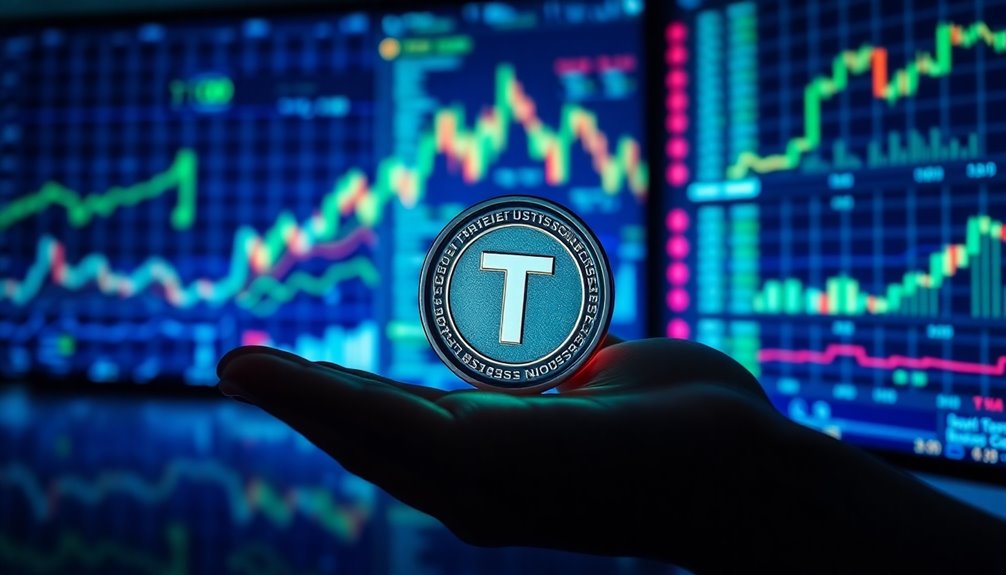Tethering crypto mainly refers to using Tether (USDT), a stablecoin pegged to the US dollar at a 1:1 ratio. This means it minimizes price fluctuations, making it a reliable medium of exchange in the volatile crypto market. Each USDT is backed by equivalent US dollars held in reserve, ensuring stability and trust among users. Tether offers quick transfers and predictability but comes with regulatory scrutiny and potential vulnerabilities. So, if you're looking to understand its advantages, risks, and how it compares to traditional currencies, there's much more to explore on the topic.
Key Takeaways
- Tether (USDT) is a stablecoin pegged to the US dollar at a 1:1 ratio, minimizing price volatility.
- It is backed by equivalent US dollars held in reserve, ensuring stability in the cryptocurrency market.
- Tether is primarily used for quick transactions and as a medium of exchange to avoid losses during market fluctuations.
- Regulatory scrutiny and compliance measures are critical for maintaining trust and stability in Tether's operations.
- High trading volumes and market liquidity enhance investor confidence and contribute to Tether's price stabilization.
Tethering as a Stablecoin Concept

While many cryptocurrencies experience wild price fluctuations, Tether (USDT) stands out as a stablecoin designed to maintain a consistent value by pegging itself to the US dollar at a 1:1 ratio.
This pegging minimizes price volatility, allowing each Tether token to be backed by an equivalent amount of US dollars held in reserve. As a result, Tether's value consistently hovers around one US dollar, making it a safer digital asset in a turbulent market. Tether's ability to provide stability in the volatile cryptocurrency market is a crucial advantage for users navigating price swings.
You can use Tether as a stable medium of exchange to avoid losses from price swings in other cryptocurrencies. This stability not only aids traders looking to hedge but also supports businesses in financial planning, lending, and borrowing within the decentralized finance (DeFi) sector.
Overview of Tethering Crypto

Tethering crypto, particularly through stablecoins like Tether (USDT), provides a unique solution to the inherent volatility of the cryptocurrency market. By pegging its value to the US dollar at a 1:1 ratio, Tether minimizes price fluctuations, offering stability for traders and investors. Its widespread adoption across numerous exchanges enhances liquidity, allowing you to swiftly switch between cryptocurrencies without hefty transaction fees. Tether enables fast, cross-border payments, facilitating global transactions seamlessly. Additionally, it offers stablecoins tied to various fiat currencies, diversifying your options. With growing investment opportunities and the ability to hedge during market downturns, Tether stands out as a convenient and effective tool in the crypto landscape. Furthermore, Tether serves as a liquidity provider in the cryptocurrency market, facilitating trades and enhancing overall market efficiency.
Mechanism of Value Stabilization

To ensure a stable value, Tether employs a robust mechanism of collateralization, which involves backing each USDT token with traditional fiat currencies.
Each USDT is matched by an equivalent amount of fiat, like the U.S. dollar, stored in a designated bank account. This 1:1 value ratio is crucial for maintaining trust in Tether. Tether's market cap of nearly $99 billion as of March 2024 underscores its significance in the cryptocurrency market.
Tether Limited manages these reserves carefully, ensuring they cover all USDT tokens in circulation. Regular audits and transparency reports confirm the existence of these reserves, preventing any depletion that could destabilize value.
Pros and Cons of Tethering

Understanding the pros and cons of using Tether can help you navigate the complexities of cryptocurrency transactions more effectively.
On the upside, Tether offers convenience and stability, maintaining a 1:1 value ratio with the U.S. dollar, which reduces volatility. It allows for quick, cost-effective transfers between exchanges and provides predictability for businesses. Additionally, Tether's steady growth in rate and market capitalization reflects its increasing popularity among cryptocurrency users.
However, you should be aware of the potential downsides. Tether faces regulatory scrutiny, raising trust issues regarding its reserves. The centralized control contrasts with the decentralized nature of other cryptocurrencies. Additionally, it doesn't generate profits and is vulnerable to market downturns.
Ultimately, weighing these factors can guide your decisions on using Tether in your cryptocurrency dealings.
Stablecoins vs. Traditional Currencies

The rise of stablecoins like Tether is reshaping how we view money in the digital age, especially when comparing them to traditional currencies.
Stablecoins are pegged 1:1 to less volatile assets, ensuring consistent value through reserves or algorithmic formulas. This stability allows you to use them as a reliable medium of exchange, facilitating instant global payments that traditional fiat transactions can't match. Moreover, stablecoins reduce volatility compared to traditional cryptocurrencies, serving as a predictable store of value.
While fiat transactions can take days, stablecoin transactions settle in seconds to an hour. Moreover, stablecoins offer a hedge against local inflation and economic instability, preserving purchasing power.
Regulatory Scrutiny and Compliance

Compliance has become a critical focal point for stablecoins like Tether as regulatory frameworks tighten. Under the EU's MiCA regulations, effective December 30, 2024, stablecoin issuers must secure an e-money license to operate, a requirement Tether hasn't met yet. While Circle has obtained its license, this puts Tether at a disadvantage. Exchanges like Coinbase have already delisted USDT due to compliance concerns, while others await further guidance.
The lack of clarity surrounding Tether's reserves and compliance status fuels fear, uncertainty, and doubt in the market. Ongoing legal challenges and scrutiny from authorities only add to the pressure. As regulatory requirements evolve, Tether's ability to maintain market stability and liquidity will be closely watched. Furthermore, Tether faces increasing regulatory scrutiny due to MiCA, which could further impact its standing in the market.
Emerging Regulatory Frameworks

As regulatory landscapes evolve, stablecoin issuers like Tether must navigate a complex web of emerging frameworks designed to balance innovation with consumer protection. You'll notice that federal licensing proposals are gaining traction, while state chartering options remain uncertain due to bipartisan divisions in Congress. Policymakers aim to create a regulatory framework that fosters responsible innovation while managing risks, including robust reserve management and capital requirements. Enhanced monitoring for AML and KYC compliance will likely be mandatory, pushing issuers to adopt more stringent practices. Moreover, concerns about systemic risk and the need for operational responsibilities emphasize the importance of transparency and accountability in this evolving landscape. Stablecoins may serve as a dollar substitute in countries with weak currencies, enhancing their appeal. Adapting to these changes will be crucial for sustainable growth in the stablecoin market.
Diversify Your Stablecoin Holdings

While navigating the unpredictable waters of the crypto market, diversifying your stablecoin holdings can significantly enhance your investment strategy. By spreading your investments across various stablecoins, you can mitigate the risk of a single coin's failure or sudden peg loss.
Different stablecoins offer varying interest rates and stability mechanisms, so you can capitalize on opportunities that suit your risk tolerance. Consider collateralized stablecoins for security, algorithmic options for potential higher yields, or hybrids for a balance of both. Additionally, understanding the types of stablecoins, such as collateralized stablecoins, can help you make more informed investment decisions.
Always evaluate their stability mechanisms, trading volumes, and issuer practices to ensure reliability. This approach not only bolsters your portfolio's resilience against market fluctuations but also protects you from unexpected events in the crypto landscape.
Frequently Asked Questions
How Do I Buy and Sell Tethering Crypto?
To buy and sell Tether (USDT), you'll start by creating an account on a global cryptocurrency exchange like Binance or Kraken.
After verifying your identity, link your funding source and select how much USDT you want to buy.
When selling, transfer your USDT to the exchange, choose the sell option, and enter the amount.
Finally, confirm the transaction to receive your funds. It's that simple to manage your Tether transactions!
What Are the Risks Associated With Tethering Crypto?
Imagine sailing on a boat held by a single anchor. That's like relying on Tether's centralized control. If that anchor fails, you drift into risky waters.
You're trusting Tether to manage reserves, but past controversies raise doubts. Their transparency issues are like fog obscuring your view, while regulatory entanglements resemble hidden rocks beneath the surface.
If the market shifts, your boat could capsize, leaving you vulnerable to financial turmoil and instability.
Can Tethering Crypto Be Used for Daily Transactions?
Yes, you can definitely use tethering crypto for daily transactions.
It's widely accepted by various businesses, allowing you to book flights and hotels seamlessly.
You'll find it supported by many digital wallets and payment processors, making global payments easy without currency conversion hassles.
Plus, its stable value helps you avoid the volatility common with other cryptocurrencies, ensuring your transactions are quick and reliable, whether you're shopping online or sending money internationally.
How Is Tethering Crypto Different From Bitcoin?
Tethering crypto differs from Bitcoin mainly in stability and purpose.
While Tether's value sticks to the US dollar, making it a stablecoin, Bitcoin's price fluctuates wildly.
You'll find Tether useful for consistent transactions and preserving value, whereas Bitcoin serves as both a medium of exchange and an investment.
Moreover, Tether operates across multiple blockchains, while Bitcoin is confined to its own, enhancing Tether's interoperability in various platforms.
What Wallets Support Tethering Crypto Storage?
To store USDT, you'll want to choose a wallet that supports its various blockchains.
MetaMask works well for Ethereum, while Trust Wallet supports multiple chains.
If you're looking for a hardware option, Ledger Live and Trezor are solid choices.
Ensure your wallet matches the blockchain version of USDT you're using to avoid compatibility issues.
Many exchanges like Binance and Kraken also allow you to store and trade USDT easily.
Conclusion
In the ever-shifting landscape of cryptocurrency, tethering acts as a sturdy anchor, stabilizing your investments against the turbulent waters of market volatility. By understanding its mechanisms and implications, you're not just safeguarding your assets; you're navigating toward a brighter financial horizon. Just as a ship relies on a reliable mooring, diversifying your stablecoin holdings can help you weather storms ahead. Embrace the balance tethering offers, and steer confidently through the cryptographic seas.









